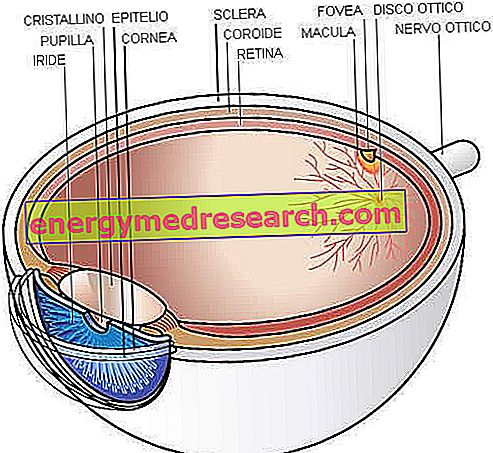What is Uvea?
The uvea is the vascular tunic of the eye, interposed between the sclera (fibrous external layer) and the retina (internal nervosa). From the anatomical point of view, the uveal tract includes the iris, the ciliary body and the choroid.
The uvea is characterized by the presence of numerous blood and lymphatic vessels, responsible for supplying nutrients and oxygen to most ocular structures. For this reason, an inflammatory process affecting the uveal lining can also have consequences in the cornea, retina, sclera and other eye tissues.
The uvea also contains the intrinsic muscles of the eyeball that allow accommodation, and regulates the secretion and reabsorption of the aqueous humor.

How it is done
The uvea is a predominantly vascular anatomical structure, placed between sclera (the white part of the eye) and retina (the innermost membrane formed by photoreceptors, light-sensitive cells).
The uvea can be divided into three parts, respectively in anteroposterior direction:
- Iris : ring of pigmented muscle tissue that widens and shrinks, behaving like a diaphragm, changing the diameter of the anterior opening (pupil);
- Ciliary body : includes the ciliary muscle, which allows the set of movements necessary to focus the observed image (accommodation process);
- Choroid : rich in blood vessels, it irrigates most of the tissues of the eyeball.
Iris
The iris is the anterior part of the vascular habit and is the only component of the uvea to be visible through the cornea. This structure appears as a thin membrane with an annular shape, placed like a diaphragm in front of the crystalline lens (which acts as a lens).
In the center, the iris has a central foramen, the pupil, whose diameter can be modified, thanks to the sphincter and dilator muscle, depending on the intensity of the light.
The iris is also responsible for the characteristic color of our eyes.
Ciliary body
The ciliary body begins at the sclerocorneal junction and extends up to the locked hour which marks the limit with the choroid behind it; its anterior portion (including the ciliary muscle and ciliary processes) is related to the peripheral part of the iris.
The ciliary body is the ocular structure assigned both to the production of the aqueous humor, and to the control of accommodation (focusing of the images). In fact, through the ciliary muscle, this part of the uvea acts by regulating the curvature of the crystalline lens, to which it is connected through the suspensory ligaments of the same (zonular fibers).
Choroid
The choroid is formed by an extensive network of blood vessels deriving from the ophthalmic artery. This portion of the uvea brings nourishment and oxygenation to the retina and sclera.
The choroid is also made up of melanocytes which, to different degrees, give different degrees of coloration to the ocular fundus. These pigments have the important function of absorbing the light that reaches the back of the eye, preventing reflection (a phenomenon that would cause distortions of the visual image).
Functions
The uvea performs the following functions:
- It represents the access route for the vessels that supply the eye;
- Adjust the amount of light entering;
- Improves the contrast of the retinal image, reducing the reflection of light rays inside the eye;
- It secretes and reabsorbs the aqueous humor that circulates in the eyeball;
- Check the shape of the lens in the focusing process.
Many of these functions are under the control of the autonomic nervous system.
Diseases of the Uvea
Uveitis
Uveitis is the inflammation of one of the components of the uveal tract (iris, ciliary body or choroid):
- When the uvea is inflamed in its anterior part, at the level of the iris, we speak of iritis (inflammation in the anterior chamber only) or of iridocyclitis (inflammation in the anterior chamber and in the anterior vitreous);
- If the inflammation is localized in the intermediate part of the uvea (ciliary body) we speak, instead, of cyclite ;
- Finally, as regards the posterior part of the uvea (choroid), they are distinguished on the basis of the location of the initial inflammatory process: choroidite, retinitis, chorioretinitis and retinocoroidite .
The most common uveitis symptoms include hypersensitivity to light (photophobia), oculodynia, eye redness, the perception of moving bodies and reduced vision. Other manifestations depend on the location and severity of the inflammation. If neglected, uveitis can have serious consequences for eyesight, including cataracts, glaucoma, retinal detachment and permanent blindness.
Uveitis can be the result of various eye and non infections (herpes simplex and zoster, mumps, toxoplasmosis, TB, syphilis, Lyme disease, etc.), traumas and systemic diseases, many of which are autoimmune. Possible causes include multiple sclerosis, sarcoidosis and various spondyloarthropathy. In many cases, however, uveitis is idiopathic, so the etiology remains unknown.
Treatment depends on the cause, but is usually based on the use of topical corticosteroids or injected intraocularly, associated with a cycloplegic-mydriatic drug, to reduce inflammation and pain. On the other hand, serious and refractory cases may require the use of corticosteroids or systemic immunosuppressants. Infectious uveitis requires specific antimicrobial therapy.
- Panuveiti. When inflammation is widespread and affects all layers of the uvea simultaneously, we speak of panuveitis .
- Endophthalmitis . Endophthalmitis is an acute panuveitis, deriving, more often than not, from the metastatic spread of bacterial, fungal and viral infections. This condition represents a medical emergency, as the prognosis for vision is directly related to the time that elapses from the onset of inflammation to treatment.
Most cases follow surgery and eye trauma. Sometimes, acute sterile endophthalmitis, an expression of hypersensitivity reactions, can be observed.
This severe inflammation of the eyeball typically causes intense eye pain, conjunctival hyperemia and reduced vision. In some cases, untreated intraocular infections extend beyond the boundaries of the eye and involve the orbit and central nervous system.
The therapy involves the intravitreal (and possibly intravenous) administration of broad-spectrum antibiotics (eg vancomycin and ceftazidime). Thereafter, the treatment must be adapted based on the results of the culture and the antibiogram. Sometimes the use of intraocular corticosteroids (with the exception of fungal endophthalmitis) and vitrectomy are considered. Visual prognosis is often poor, even with early and adequate treatment.
Congenital anomalies of the uvea
Among the congenital malformations of the eye that affect the iris, the ciliary body and the choroid include colobomas, or slit-shaped lesions, from which more or less serious defects of vision occur. Such diseases can occur sporadically or in the context of various genetic syndromes.
Uvea tumors
Uveal tumors include melanomas of the iris and, above all, those of the choroid. The damage caused by these tumors affects the visual function and the integrity of the eye. The uvea can also be the site of metastases, deriving, in particular, from a breast or lung cancer.
Melanoma of the choroid
Choroid melanoma is the most common malignant primary intraocular tumor in adults.
The neoplastic process originates from the choroidal melanocytes and can spread locally, internally infiltrating the bulb or the most external orbital tissues. Choroid melanoma can also cause distant metastases.
The presentation of the disease occurs more often at an age between 50 and 60 years. Choroid melanoma symptoms tend to develop late and are not specific; Possible manifestations include: reduction of visual acuity, visual field deficiency, phosphenes (flashes of light, sometimes colored) and metamorphopsia (distorted vision). Other symptoms reported by patients may be attributed to a concomitant retinal detachment.
The diagnosis is based on the examination of the ocular fundus, integrated, when indicated, by other tests, such as fluorangiography, bulbar ultrasound and CT.
Treatment varies according to the location and size of the tumor. Small tumors are treated with laser, radiotherapy or brachytherapy, in order to preserve the visual function and save the eye. Local resection is rarely performed. Large tumors, on the other hand, require enucleation (removal of the entire eyeball).
Choroidal metastases
As the choroid is richly vascularized, choroidal metastases are frequent, especially if they derive from breast cancer in women and from lung and prostate tumors in men.
Sympathetic ophthalmia
Sympathetic ophthalmia (OS) is a rare granulomatous anterior uveitis that occurs after penetrating traumas, bruises or surgery to the contralateral eye (therefore not directly affected by the triggering event).
The etiology of the disorder has not yet been clarified. However, at the origin of the inflammatory process an autoimmune reaction was found directed against the ocular auto-antigens that form following the initial lesion.
Generally, inflammation of the uveal tract occurs within 2-12 weeks. Symptoms typically include: loose bodies, pain, photophobia, paresis of accommodation, metamorphopsia and vision loss. Sympathetic ophthalmia is frequently associated with pathological processes affecting the posterior segment, including choroiditis, macular edema and exudative retinal detachment.
Treatment usually requires the administration of high dose oral corticosteroids (for at least 3 months), associated with immunosuppressive drugs (cyclophosphamide, azathioprine or cyclosporine). The timely closure of the wound decreases the risk of sympathetic ophthalmia.



